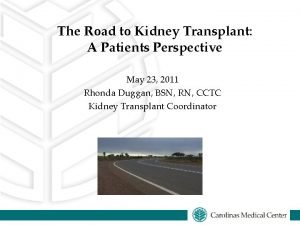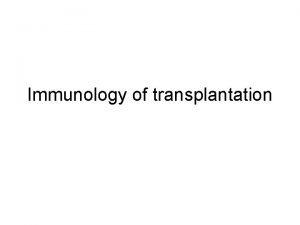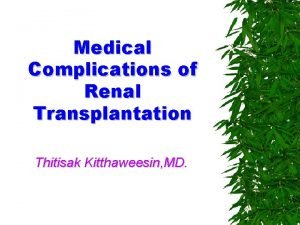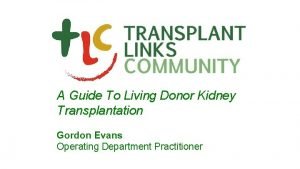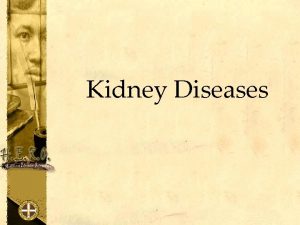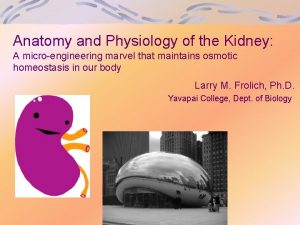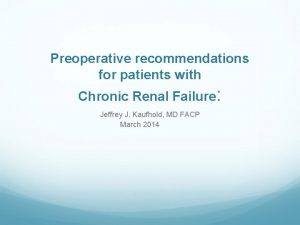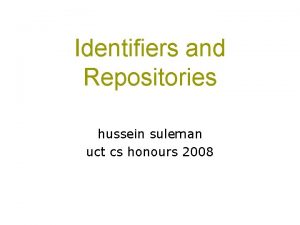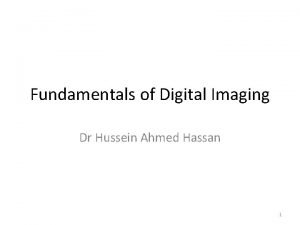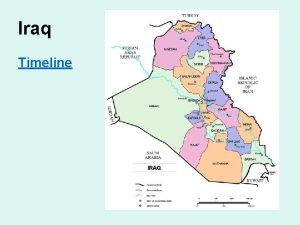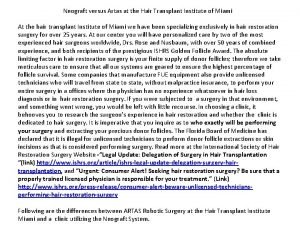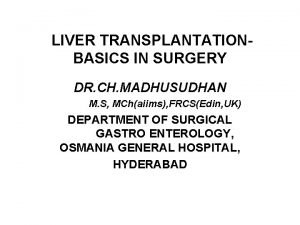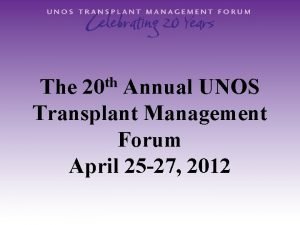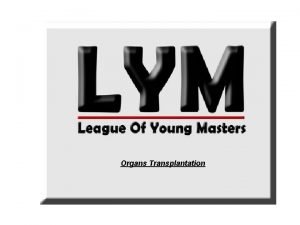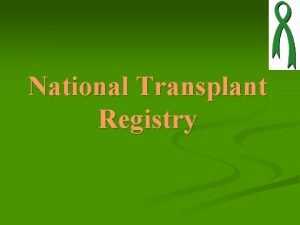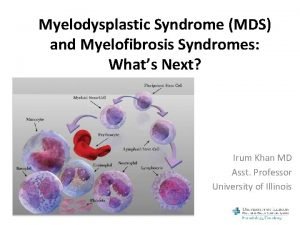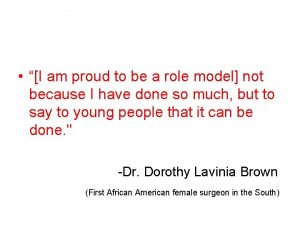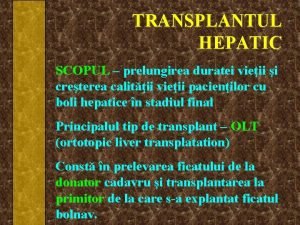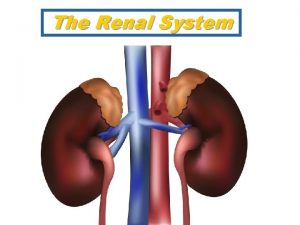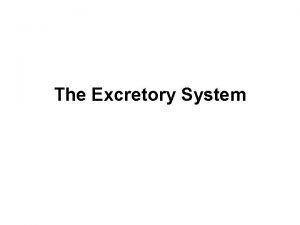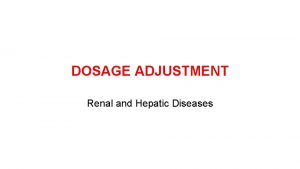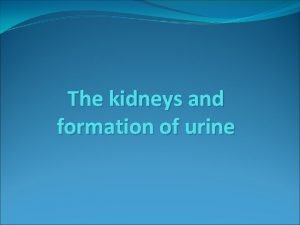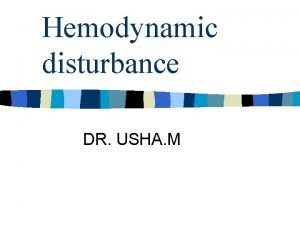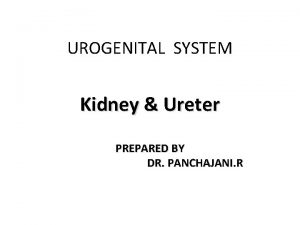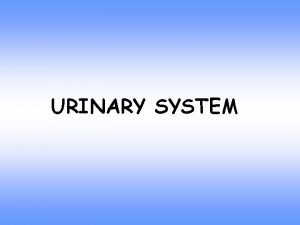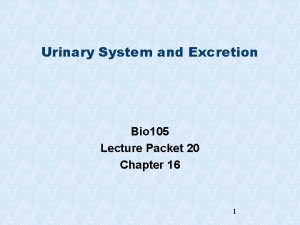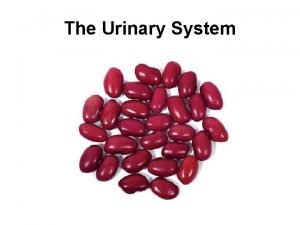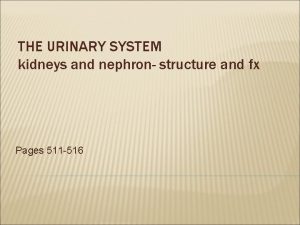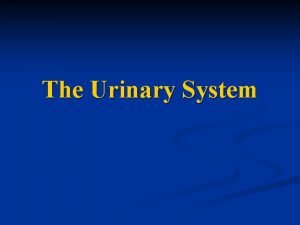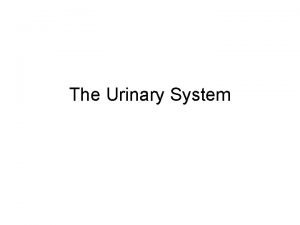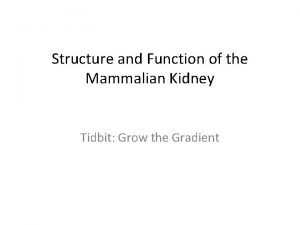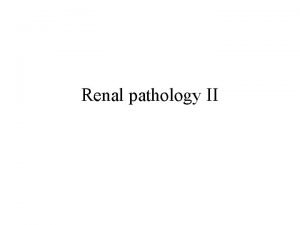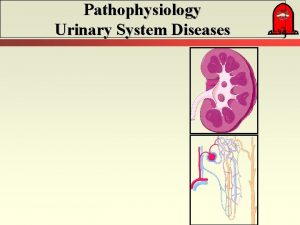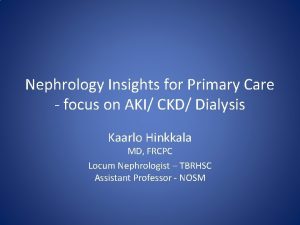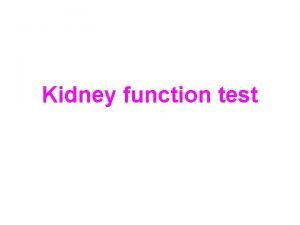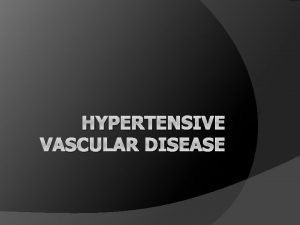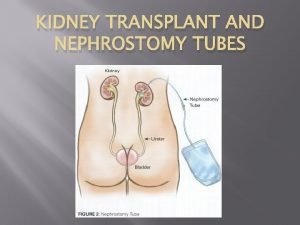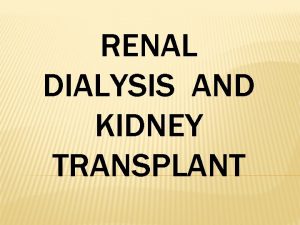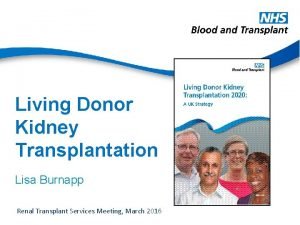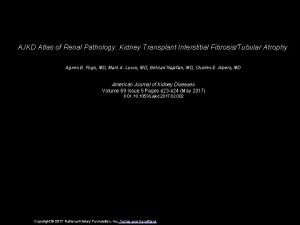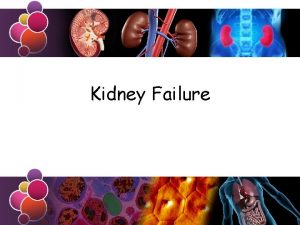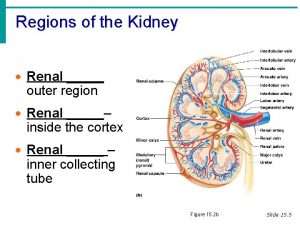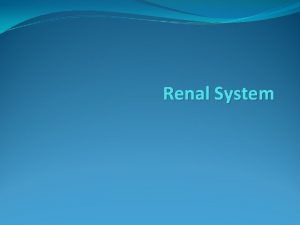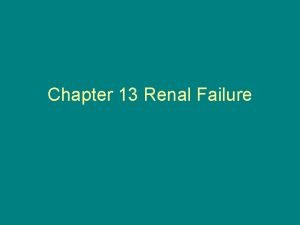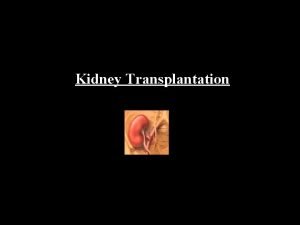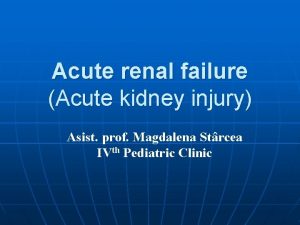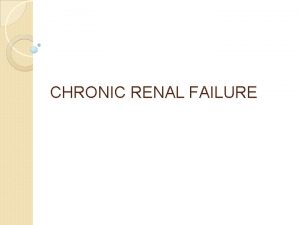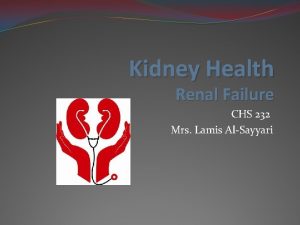RENAL FAILURE KIDNEY TRANSPLANT HISTORY AND PROGRESS HUSSEIN



















































































- Slides: 83

RENAL FAILURE & KIDNEY TRANSPLANT: HISTORY AND PROGRESS HUSSEIN K. MOHAMED MD, Ph. D, FACES Affiliated Ass. Professor at USF Clinical Faculty Member at NOVA Univ. Chief of Transplant and Hepato-biliary Surgery LARGO MEDICAL CENTER HCA

DISCLOSURE • I have no financial relationship(s) relevant to the content of this CME activity. • I will not discuss off-label use of medications.

RENAL FAILURE • Definition: Failure of kidney to adequately filters blood from the waste products of metabolism. • Types: – A)- Acute Renal failure ( usually reversible). – B)- Chronic Renal failure ( irreversible).

INCIDENCE & EPIDEMIOLOGY OF KIDNEY DISEASE • One in 10 American, more than 20 million, have some level of CKD.

INCIDENCE RATE OF RENAL FAILURE IN THE USA.

INCIDENCE & EPIDEMIOLOGY OF KIDNEY DISEASE

OPTIONS FOR TREATING PATIENT WITH ESRD • 1 - DIALYSIS: - Hemodialysis or Peritoneal dialysis • 2 -KIDNEY TRANSPLANT: - Cadaveric or Live donor • 3 -DO NOTHING: = DEATH

HISTORY OF HEMODIALYSIS

HISTORY OF HEMODIALYSIS

FINANCIAL BURDEN

FINANCIAL BURDEN


LIMITATION OF DIALYSIS • COST; $87, 945 PPPY for hemodialysis and $71, 630 PPPY for peritoneal dialysis • Vascular access problems. • Impaired quality of life. • Risk of disease transmission.

CAUSE OF MORTALITY ON DIALYSIS

PATIENT SURVIVAL AFTER DIALYSIS AND KIDNEY TRANSPLANT

HISTORY OF KIDNEY TRANSPLANT • 1902: The first successful experimental kidney transplants were performed at the Vienna Medical School in Austria with animals. • 1933: The first human renal transplant by Voronoy soviet Surgeon. A 60 year old donor to a 26 year old recipient. • 1950: The first kidney transplantation was performed on, a 44 -year-old woman with polycystic kidney disease, at Little Company of Mary Hospital in Evergreen Park, Illinois. Although the donated kidney was rejected ten months later • 1952: The first kidney transplants between living patients were undertaken at the Necker hospital in Paris by Jean Hamburger although the kidney failed after 3 weeks of good function

FIRST SUCCESSFUL KIDNEY TRANSPLANT 1954: The first successful kidney transplant between 2 twins by Dr. Murray.

FIRST SUCCESSFUL KIDNEY TRANSPLANT • Ten months after the transplant, Ronald Herrick (left) and his identical twin Richard toast their good health.

REUNION AFTER 50 YEARS • In July 2004, transplant pioneer Dr. Joseph Murray (left), 85, was reunited with his first organ donor, Ronald Herrick, 73, at the U. S. Transplant Games in Minneapolis. Richard Herrick died eight years after his kidney transplant

OBSTCLES ON THE ROAD • • PRESERVATION SURGICAL MANIPULATION I/R INJURY CHRONIC REJECTION • ACUTE REJECTION • SEPSIS

CORNER STONE IN IMMUNOSUPPRESSION Sir Peter Brian Medawar. Brazilian/British biologist, whose work on graft rejection and the discovery of acquired immune tolerance was fundamental to the practice of tissue and organ transplants. He was awarded the 1960 Nobel Prize in Physiology or Medicine

CORNER STONE IN IMMUNOSUPPRESSION • 1960: Schwartz and Dameshek in Boston developed a 6 -Mercaptopurine analogue “ Azathioprine” • !983: Cyclosporine was introduced as an effective antirejection medicine by Sir Roy Yorke Calne • !989 : Fk 506 ( Tacrolimus ) has been introduced by Thomas Starzle as a potent antirejection medicine.

CORNER STONE IN IMMUNOSUPPRESSION 1 -Sir Roy Calne introduce CYCLOSPORINE IN 1970 2 - Thomas Starzl introduce the FK 506 (Prograf) in 1989

PRESERVATION SOLUTION • The pioneering work by Collins and his colleagues led to the design of an acellular solutions termed (Collins solutions) In the mid 1960 s. • UW solution: Introduced by Belzer and coworkers in the mid 1980 s. • HTK solution: was introduced in late 1990 s.

INDICATIONS FOR KIDNEY TRANSPLANTATION • IRREVERSIBLE END STAGE RENAL DISEASE REQUIRING OR APPROCHING THE NEED FOR RENAL REPLACEMENT THERAPY

INDICATIONS FOR KIDNEY TRANSPLANTATION • Glomerulonephritis • • • Idiopathic and post infectious crescentic Membranous Mesangiocapillary (Type I) • Mesangiocapillary (Type II) (dense-deposit • • disease) Ig. A nephropathy Antiglomerular basement membrane Focal glomerulosclerosis Henoch-Schonlein • Chronic pyelonephritis (reflux nephropathy) • Hereditary • • Polycystic kidneys Nephronophthisis (medullary cystic disease) Nephritis (including Alport's syndrome) Tuberous sclerosis • Metabolic • • • Diabetes mellitus Hyperoxaluria Cystinosis Fabry's disease Amyloid Gout Porphyria Obstructive nephropathy Toxic Analgesic nephropathy Opiate abuse

INDICATIONS FOR KIDNEY TRANSPLANTATION • Multisystem Diseases • • • Systemic lupus erythematosus Vasculitis Progressive systemic sclerosis • • Haemolytic uraemic syndrome • • Incidental carcinoma Myeloma • Congenital • • Hypoplasia Horseshoe kidney • Irreversible Acute Renal Failure • • Cortical necrosis Acute tubular necrosis Tumors Wilms' tumor Renal cell carcinoma

INDICATIONS FOR KIDNEY TRANSPLANTATION THE CHIEF CAUSES OF ESRD IN CHILDRENS ARE: • • Obstructive uropathy Hypoplastic or dysplastic kidneys Reflux nephropathy Focal segmental glomerulosclerosis as a variant of childhood nephritic syndrome • Polycystic kidney disease, autosomal-recessive and autosomal-dominant varieties

INDICATIONS FOR KIDNEY TRANSPLANTATION THE CHIEF CAUSES OF ESRD IN ADULTS ARE: 1 - Diabetic nephropathy 2 - Hypertensive nephropathy 3 - Glomerulonephritis 4 - Others

CONTRAINDICATIONS FOR KIDNEY TRANSPLANTATION • ABSOLUTE CONTRAINDICATIONS FOR KIDNEY TRX: – Active infection – Active malignancy – Active drug use, alcoholism, or psychosis. – Medical noncompliance – BMI > 40. – Anatomy that makes transplantation technically impossible

CONTRAINDICATIONS FOR KIDNEY TRANSPLANTATION • • Severe pulmonary hypertension. Severe cardiopulmonary disease Liver cirrhosis with portal hypertension AIDS (positive HIV)

CONTRAINDICATIONS FOR KIDNEY TRANSPLANTATION RELATIVE CONTRAINDICATIONS FOR KIDNEY TRANSPLANTATION: • A. Significant cardiac disease • B. Significant pulmonary disease • C. Significant gastrointestinal disease • D. Severe vascular disease: coronary, cerebral or peripheral • E. Renal disease with significant potential for recurrence causing kidney graft loss

CONTRAINDICATIONS FOR KIDNEY TRANSPLANTATION • • F. Potential for noncompliance H. BMI>35 I. Age greater than 70 years G. Psychosocial/financial issues causing an inability to achieve adequate post-transplant care • K. History of cancer.

PROCESS OF EVALUATION AND LISTING Referral received Coordinator review referral packet Get authorization Schedule ICV Receive evaluation testing Start evaluation or end referral Seen in clinic for surgery appt. Go to surgery or end referral Present at selection committee List, Differ, or ineligible

SELECTION COMMITTEE ESSENTIAL MEMBERS OPTIONAL • • • Transplant Surgeon Transplant Nephrology Pre-transplant Coordinator Post-transplant Coordinator Social Worker Financial Specialist Transplant/ Hospital administrator Psychology ID Cardiology Anesthesia.

SURGERY

SURGERY

IMMUNOSUPPRESSION INDUCTION THERAPY: MAINTINANCE THERAPY: • • • Thymoglobulin Atgam Basiliximab (Simulect) Alemtuzumab (Campath) OKT 3 Prograf ( Tacrolimus ) Cyclosporine ( Neoral ) Rapa-immune. Imuran Prednisone. Cellcept ( MMF)

IMMUNOSUPPRESSION

COMPLICATIONS AFTER KIDNEY TRANSPLANT • Early Graft dysfunction: – Primary non-function (PNF) – Delayed graft function (DGF) – Vascular thrombosis • Rejection

KIDNEY REJECTION

HYPERACUTE REJECTION

KIDNEY REJECTION

COMPLICATIONS AFTER KIDNEY TRANSPLANT • Graft dysfunction: – Primary non-function (PNF) – Delayed graft function (DGF) – Vascular thrombosis • • • Rejection Infection High Blood Pressure Post-Transplant Diabetes Lymphocele

RECURRENCE OF THE PRIMARY DISEASE • Diseases which may recur in renal transplants are listed below: -Ig. A nephropathy -Focal segmental glomerulosclerosis -Membranous glomerulonephritis -Membranoproliferative glomerulonephritis -Amyloidosis -Cystinosis

CAUSE OF MORTALITY

ORGAN SHORTAGE • Every ten minutes, someone is added to the national transplant waiting list. • On average, 21 people die each day while waiting for a transplant.

ORGAN SHORTAGE

INCREASE IN THE WAITING LIST TIME

EFFECT OF PROLONGED WAITING TIME BEFORE TRANSPLANT

HOW WE CAN NARROW THE GAP ? 1 - Increasing the donor pool: - - public education - - Educate health care professionals - expanding donor criteria - New organ allocation system. 2 - Increase longevity of the graft: - - refinement of surgical techniques - - refinement of immunosuppression 3 - xenotransplantation: -? ? 4 - Increasing live donation:

ADVANTAGES OF LIVE KIDNEY DONOR TRANSPLANT • • • Improved patient and graft survival Avoids prolonged time on the waiting list Elective surgery Decreased incidence of delayed function Decreased costs Increases the organ supply

ADVANTAGES OF LIVE KIDNEY DONOR TRANSPLANT

EFFECT OF PROLONGED WAITING TIME AFTER TRANSPLANT

DISINCENTIVES TO LIVE DONATION Prolonged convalescence. Fear of pain Cosmetic concerns • 2013 Living Donor Age Breakdown: • • Ages 18 -34: 29. 8% Ages 35 -49: 40. 9% Ages 50 -64: 27. 2% Age 65+: 2. 1% • 2013 Living Donor Gender Breakdown: • Male: 38. 6% • Female: 61. 4%

OPEN DONOR NEPHRECTOMY

MINIMAL INVASIVE PROCEDURE • Revolution over the past 2 decades • Applied to a myriad of procedures • Decreased hospital stays • Decreased post-operative pain • Decreased recuperative times • Improve cosmetic outcome

LAPAROSCOPIC DONOR NEPHRECTOMY 1995 Ratner et al. - First Laparoscopic donor nephrectomy Ratner LE, Ciseck LJ, Moore RG, Cigarroa FG, Kaufman HS, Kavoussi LR. Laparoscopic live donor nephrectomy. Transplantation 1995; 60: 1047– 1049

TYPES OF MINIMAL INVASIVE SURGERY FOR DONOR NEPHRECTOMY • Total laparoscopic donor nephrectomy • Hand assisted laparoscopic donor nephrectomy • SILS Trans-umbilical laparoscopic donor nephrectomy • Trans-vaginal laparoscopic donor nephrectomy. • Robotic donor nephrectomy

PATIENT SELECTION • All candidates for living kidney donation are potential for the laparoscopic nephrectomy • Relative contraindications: – Previous abdominal surgery – Abnormal renal anatomy – BMI? • Radiological Evaluation of the Renal Anatomy l Standard angiography with IVP l “State of the Art” 3 D CT reconstruction

THE 3 D CT

THE 3 D CT

THE 3 D CT

THE 3 D CT

THE 3 D CT

THE PROCEDURE

10 DAYS POST LAPAROSCOPIC DONOR NEPHRECTOMY

10 DAYS POST LAPAROSCOPIC DONOR NEPHRECTOMY

Does kidney donation affect the life expectancy of the donor? • Interestingly, people who have donated a kidney outlive the average person. (Reference: Fehrman-Ekholm, Ingela 2, 3; Transplantation, 64(7): 976 -978, October 15, 1997. ) • Donating a kidney is major surgery but does not reduce a person's life expectancy

ESRD PATIENTS BY TREATMENT MODALITIES

CURRENT STATUS OF KIDNEY TX. WAITING LIST CANDIDATES • All 123, 448 • Kidney 101, 748 • • 1, 078 2, 012 15, 290 247 4, 103 1, 606 38 Pancreas Kidney/Pancreas Liver Intestine Heart Lung Heart/Lung

KIDNEY TRANSPLANT IN THE US

TYPES OF KIDNEY DONATION 1 - Directed Kidney donation 2 - Paired kidney donation 3 - Samaritan kidney donation

PAIRED KIDNEY DONATION

KIDNEY CHAIN DONATION

ADVANTAGES OF KIDNEY TRANSPLANT VIA NKR

NEW KIDNEY ALLOCATION SYSTEM (KAS) • • • WAITING TIME KDPI EPTS DEGREE OF SENSITIZATION PEDIATRIC PATIENTS EARLY REFERRAL TO TRANSPLANT

FUTURE OF KIDNEY TX. • • More improvement in immunosuppression. Desensitization of recipient with high PRA. Organ shortage. Expanding of PKD and NKR. • Xenotransplantation.

KIDNEY TRANSPLANT STAND THE TEST OF TIME SOME THINGS COME AND GO AND OTHERS STAND THE TEST OF TIME

CONCLUSION • Major achievements in treating patient with Renal failure occurred during the past century. • The major corner stones in kidney transplant were the development of antirejection medicine, preservation solution, and surgical techniques. • • Kidney transplant proved to be superior to dialysis both in cost, patient quality of life and patient survival.

CONCLUSION • LDN with its advantages of less pain, shorter hospitalization, minimal scarring, and quicker recuperation increased the number of individuals willing to donate. • The future will depends on more refinement of immunosuppression, expansion of shared donation and more research in the field of xenotransplantation

QUESTION ?

Centers performing adult kidney transplants in 2012, within Donation Service Areas (DSAs)
 Ira pré renal renal e pós renal
Ira pré renal renal e pós renal Ira pré renal renal e pós renal
Ira pré renal renal e pós renal Disadvantage of kidney transplant
Disadvantage of kidney transplant How does a kidney transplant work
How does a kidney transplant work Intraosseous
Intraosseous Kidney donor transplant
Kidney donor transplant Cortical and juxtamedullary nephrons difference
Cortical and juxtamedullary nephrons difference Kidney failure and foamy urine pictures
Kidney failure and foamy urine pictures Inside a kidney the ureter expands as a renal pyramid
Inside a kidney the ureter expands as a renal pyramid How to prevent kidney failure
How to prevent kidney failure Earthy look in chronic renal failure
Earthy look in chronic renal failure Treatments for acute renal failure
Treatments for acute renal failure 4th stage renal failure
4th stage renal failure Renal failure
Renal failure Physical progress and financial progress
Physical progress and financial progress Failure to capture vs failure to sense ecg
Failure to capture vs failure to sense ecg Vvi pacemaker
Vvi pacemaker Site:slidetodoc.com
Site:slidetodoc.com Karen hussein
Karen hussein Hassine bey
Hassine bey Taha hussein challenges
Taha hussein challenges Laila hussein
Laila hussein Alex hoffer stanford
Alex hoffer stanford Uct computer
Uct computer Hussein suleman
Hussein suleman Hussein suleman
Hussein suleman Reporaproblem
Reporaproblem Dr. hussein shaqra
Dr. hussein shaqra Mbbsch
Mbbsch Hussein suleman
Hussein suleman Bassam hussein
Bassam hussein Alhamdulillahi rahmanir rahim
Alhamdulillahi rahmanir rahim Amina audrey
Amina audrey Diyar hussein
Diyar hussein Hussein mahmood 1985
Hussein mahmood 1985 Ananda sabil hussein
Ananda sabil hussein Saddam hussein
Saddam hussein Saddam hussein
Saddam hussein Principles of primary health care
Principles of primary health care Dr rania hussein
Dr rania hussein Saddam hussein
Saddam hussein Dr hussein saad
Dr hussein saad George h. w. bush apush
George h. w. bush apush Nadya hussein
Nadya hussein Face transplant
Face transplant Slk criteria
Slk criteria Bone marrow transplant diet
Bone marrow transplant diet Neograft hair transplant miami
Neograft hair transplant miami Dr ch madhusudhan
Dr ch madhusudhan Oncogens
Oncogens Transplant management forum
Transplant management forum Face transplant
Face transplant National transplant registry malaysia
National transplant registry malaysia Next
Next Leukemia death rate
Leukemia death rate Eliza ann grier
Eliza ann grier Embryo transplant gcse
Embryo transplant gcse Citomegalvirus
Citomegalvirus Kidney
Kidney A muscular bag that holds urine
A muscular bag that holds urine Claire gibbons
Claire gibbons Lobule renal
Lobule renal Maintenance dose formula
Maintenance dose formula Bladder infection
Bladder infection Reabsorption and secretion in renal tubules
Reabsorption and secretion in renal tubules Gross features
Gross features Progress and performance measurement and evaluation
Progress and performance measurement and evaluation Progress and performance measurement and evaluation
Progress and performance measurement and evaluation Panchajani
Panchajani Bellinior
Bellinior What are the three regions of the kidney
What are the three regions of the kidney Kidney infection
Kidney infection 3 layers of the kidney
3 layers of the kidney Cortical radiate artery
Cortical radiate artery Papillary duct of bellini
Papillary duct of bellini Figure 15-4 is a diagram of a nephron
Figure 15-4 is a diagram of a nephron Medulla kidney
Medulla kidney Kidney pathology
Kidney pathology Gfr rumus
Gfr rumus Urinary tract obstruction
Urinary tract obstruction Coverings of kidney
Coverings of kidney Kaarlo hinkkala
Kaarlo hinkkala Kidney function test name
Kidney function test name Flea bitten kidney seen in
Flea bitten kidney seen in


